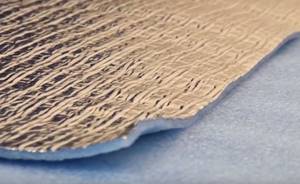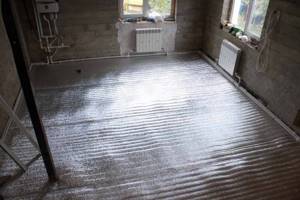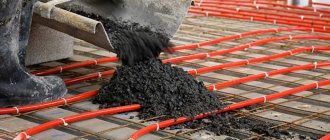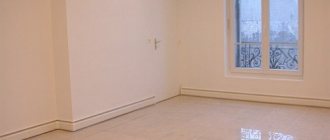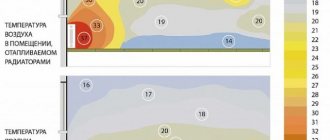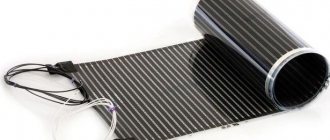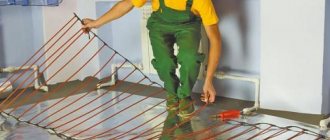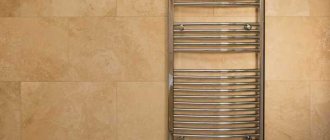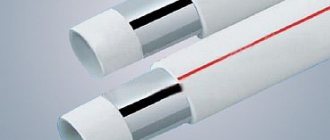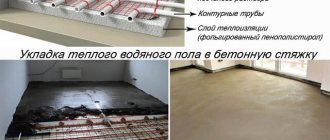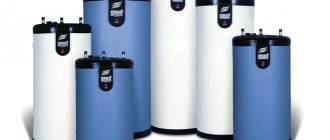Why do you need a thermal insulation substrate?
The substrate is a heat-insulating material that works like a “thermos”, and a waterproofing layer that protects against moisture. It is located between the base and the coolant, thereby softening the pressure that is exerted on the base. The main task of the substrate is to retain and transfer thermal energy upward, and not allow heat to escape into the floor.
The quality of heating is influenced by a well-equipped lining. The operation of the most powerful and expensive heating system will be ineffective if the insulation is incorrectly chosen, because the heat will be wasted.
Please note : according to technology, a heated floor system must transfer heat to at least 80% of the floor surface.
To achieve this result, it is necessary to use a heat-insulating material with low thermal conductivity in this layer of the cake. This quality allows you to reflect heat and direct it upward. That is, the underfloor heating, which is hidden under a concrete screed or located in the middle of the structure, is a key factor in effective heating.
Choosing a good substrate is not easy; you should pay attention to its practicality and manufacturability, it must be easy to use and have the necessary rigidity. Such a product will not be cheap, but it will last a long time and significantly increase the efficiency of the floor.
You can determine the best substrate by the presence of:
- good hydro- and thermal insulation properties;
- increased reflective properties;
- resistance to temperature changes, if it can withstand heating up to 90 degrees;
- resistance to deformation;
- fire resistance.
In addition, it must be environmentally friendly.
Purpose
The underlay is placed between the concrete surface in the room and the heating system. The main purpose of the material is to prevent the loss of heat that comes from the heating elements of the heated floor. Otherwise, the heat will be wasted without showing any effect. This way, only the ceiling on the floor below will warm up. If the substrate is chosen correctly, then heating of the subfloor will not only be uniform, but also twice as fast.
Another purpose of this material in a heated floor system is as a barrier. It does not let in cold, moisture, or steam from the lower floors. This is especially true for the first floors above basements. Since the substrate has excellent soundproofing qualities, in apartment buildings you will not have to listen to screams and noise from neighbors. Other materials can be used for the substrate:
- Cork.
- Fiberboard.
- Foamed polymer.
- Penofol.
- Foil material.
- Extruded polystyrene foam.
But even this cannot be called an exceptional option. Technologies do not stand still and materials are constantly being improved, which can be chosen as a substrate for electric heated floors. The choice of a specific material will depend on the levelness of the base, where the installation is carried out, as well as on the type of floor covering in the finishing.
Types of substrates
Various products that meet the above requirements can be used as a substrate.
Watch the video
Is a reflector needed under a heated floor in a screed? Experiment
Expanded polystyrene boards
Expanded polystyrene slabs for heated floors (we invite you to familiarize yourself with this coating in more detail) are a universal product, as they have a low degree of thermal conductivity compared to other models. Manufacturing method: polystyrene foaming.
The finished product is air, which is placed in sealed cells, this allows heat to be retained. A sheet 10 cm thick in terms of thermal conductivity is equal to 0.35 m of wood, a reinforced concrete base - 4.8 m, a brick wall - 1.5 m.
The foam sheet consists of the following components:
- polystyrene - 2%;
- gas - 98%.
Characteristics of polystyrene:
- thermal conductivity - 0.028-0.034 W/m*K, the indicator varies depending on the density of the product;
- water resistance - 0.019-0.015 mg/m*h*Pa;
- moisture absorption - 0.4%, which is 10 times less than standard foam;
- strength - at a deformation of 10% is 0.25-0.50 MPa.
Despite all the positive aspects, polystyrene also has disadvantages:
- low sound and waterproofing;
- flammability;
- deformation under the influence of chemical compounds (acetone, solvent).
Non-pressed or autoclaved polystyrene foam is not suitable as a thermal insulation layer, since these varieties are more fragile.
Expanded polystyrene sheets are available in several types:
- Polystyrene boards with bosses without coating - their disadvantage is that when installing a heating device, the bosses easily break off. On average, the price of a sheet is 600 rubles. per sq. meter.
- Polystyrene boards with bosses and plastic coating - product thickness 2 cm. The coating protects the bosses, the average price of a coated sheet is 680 rubles. per sq. meter. The bosses tightly fix pipes made of any material: metal-plastic or polyethylene, so there is no need for additional fasteners.

- Polystyrene smooth substrates have a lower density, thickness from 2 to 10 cm. A 2 cm slab costs about 100 rubles. The plates do not secure the pipes; this will require the installation of anchor brackets.
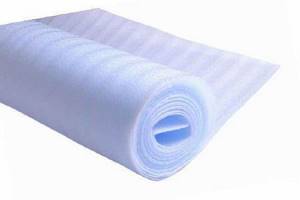
Cork material
To make cork pads, wood bark is used, which is previously crushed and pressed. The main advantage is that natural and ecological raw materials are used for its production. Therefore, the products are safe for health and non-allergenic.
In addition, cork has positive aspects:
- resistance to deformation - after mechanical impact on it, it takes its original shape;
- high noise insulation - this is ensured by the porous structure;
- good degree of thermal insulation;
- ease of cutting and installation.
The product is sold in rolls or sheets. The difference between roll and sheet substrates is in thickness: in rolls - from 2 to 4 mm, in mats - from 4 to 10 mm.
Cork, like any raw material, has disadvantages:
- susceptible to moisture;
- During installation, waterproofing of the base is required;
- does not tolerate statistical loads well.
It is not recommended to use a standard cork underlay for water heated floors. It is better to install a plug with a rubber layer, where rubber acts as a binder.
Polyethylene foam damper
Polyethylene foam lining is the most affordable option. The production process involves pressing molten material through a cellular mold, which then undergoes heat treatment and pressing. An elastic fabric with air pores comes out.

Polyethylene foam substrates are available in two types:
- Uncrosslinked - cells filled with gas, 3 mm in size. The product is produced with a thickness of 0.8 to 3 mm, a length of 1 or 1.5 meters.
The main advantages of this type:
- increased moisture resistance;
- small thickness;
- low price.
But this model has more disadvantages: fragility, wears out quickly, density is only 25 kg/cubic meter, it bends under weight and loses flexibility. In addition, the thermal conductivity is 0.55 W/(m°C), which means that the material does not store heat well.
- Cross-linked polyethylene foam boards have a dense structure, as the technology promotes the formation of cross-links that reduce the size of air cells.
Main characteristics:
- high strength;
- increased density – 33 kg/cub.m;
- the degree of noise insulation reaches up to 18 dB;
- thermal conductivity coefficient 0.031 W/(m°C);
- Available in two types: rolls and mats, the thickness of which is from 1 to 20 mm;
- service life up to 15 years.
The main disadvantage is the high cost.
Foil substrates
A substrate with a foil surface is widely used. A huge plus is that its basis can be: extruded polystyrene foam tiles, polystyrene foam, polystyrene foam or cork. The use of metallized film leads to a significant improvement in the characteristics of the base.
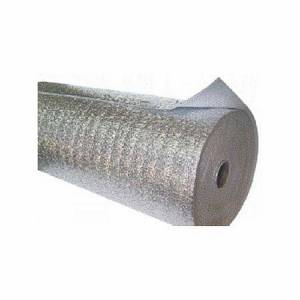
A film of aluminum or lavsan acts as a reflective outer covering. It increases the efficiency of the water system up to 98%, and affects the uniform distribution of heat. The degree of heat reflection depends on the size of the foil layer. An important property of this material is that it is not subject to deformation and can withstand heavy loads.
It is worth noting a special property of lavsan - it has the ability to maintain reflective qualities and moisture retention functions, even with prolonged contact with a concrete screed.
Wood-based materials (OSB and chipboard)
The wood-chip base is used when installing heated floors according to the Finnish method. This option makes it possible not to pour the concrete screed.
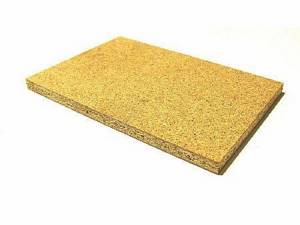
The technology consists of laying water floor pipes into grooves prepared in advance. The base is rigid due to chipboard sheets or slats, which are fastened with wooden logs.
Features of this type:
- ease of installation;
- strength;
- environmental friendliness;
- versatility - the ability to install under any type of flooring.
The disadvantages of this substrate are that it does not tolerate moisture well; it is recommended to lay a foil film between the pipe and the wooden base to improve the hydro- and heat-insulating properties.
For your information! It is worth noting that experts do not recommend using a substrate with markings as insulation for heated floors. The only thing is that this product makes the process of laying out the slabs more convenient.
Underlay for infrared heated floors
For the high-quality functioning of infrared underfloor heating, two recommendations must be followed:
- strict adherence to installation technology;
- installation of heat-reflecting material with foil facing up.
When laying a reflective layer under a heated floor, it is recommended to follow the following advice from professional craftsmen:
- Magnesite boards and particle boards. Before installing such material, an aluminum film is laid on the base, and a substrate is laid on top. For these purposes, foil layers can be used.
- Metallized polymer-based materials are mounted with the smooth side up. As a result of this installation, a thin and effective heat-reflecting coating is formed.
- The layer is laid over the entire floor surface on which the heating system will be installed. The material is laid overlapping, firmly gluing the joints with special tape. Such measures will create sufficient indicators of hydro- and thermal insulation. The adhesive tape for the backing must be metallized. Ordinary materials may not withstand heat and melt.
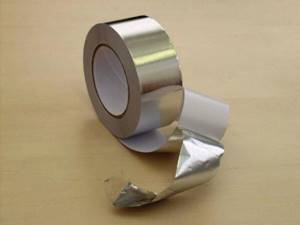
By following these simple rules, you can easily install and select a high-quality substrate yourself. Be sure to consider the composition of the material and its compatibility with your heating system.
There are reflectors that can greatly facilitate the process of installing electrical cables. These are the so-called layers with bosses. The design of such material is a carpet dotted with dense rows of protruding cylinders. These projections are called bosses. It is very convenient to lay the underfloor heating cable between them. This installation does not require additional fasteners or adhesives - the bosses firmly hold the cable on the surface of the interlayer, preventing them from moving to the side.

Features of choosing a substrate
You need to choose the substrate carefully, since not only the operation of the heated floor, but also the atmosphere in your home depends on it. Therefore, when purchasing insulation, professionals advise paying attention to the following points and making a choice based on the parameters listed below.
Video
How to choose a substrate for laminate or parquet boards? How to choose underlays for heated floors
By type of heated floor
It is necessary that the substrate meets the requirements laid down by the heating system manufacturers:
- Water floor - for this design, a foil backing with a reflective coating is used. This mat is inexpensive and is great if you want to save living space, but the type is not recommended for basement floors. For water floors, it is better to take film models; although they are more expensive, they are equipped with increased thermal properties. An excellent solution for a water structure is an extruded foam substrate with bosses; it has improved quality and ease of installation, since the pipes are laid in grooves. Choosing rolled cork or expanded polystyrene would also be a good option.
- Electric floor - foil roll or tile insulation is suitable. The presence of an aluminum reflective layer is not recommended; it is better if it is vacuum deposition. If the height allows for a thicker cake, then it is worth putting polystyrene foam with a foil layer 2 - 3 cm thick. If height is limited, polyethylene foam 2 - 3 mm can be used as thermal insulation.
For the infrared floor model, you can choose chipboard sheets or magnesite slabs, but you will first need to lay foil film.
By type of flooring
The lighter the floor covering, the more permissible it is to use an underlay with lower strength.
When installing a laminate, you can use foamed polymer, and when using ceramic tiles, which will be laid on a concrete screed, you need a substrate made of extruded material, which has increased strength.
Under linoleum, only a solid base or an additional thin concrete screed is required.
By type of base
Almost any type of substrate can be laid on both a concrete sub-base and a wooden one.
The only peculiarity when installing on a wooden floor is an increased level of waterproofing and fire resistance.
Adviсe
One of the most modern trends in solving the issue of thermal insulation at home has been the installation of a “warm floor” system. Nowadays, manufacturers have brought to the market three main options for underfloor heating - water, infrared and cable. The water method is used for large areas. This technique involves circulating hot water through pipes built into the floor. Such a system has a number of limitations:
- it cannot be used in multi-storey buildings, as it creates additional pressure on the floors;
- in the event of a breakthrough, there is still a risk of “flooding” the neighbors below, which will lead to large expenses for troubleshooting;
- high cost of materials, as well as installation work.
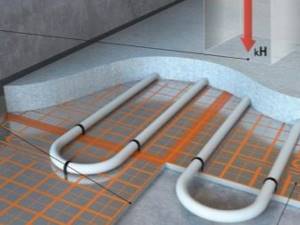
The infrared floor is a polymer film, which is divided into identical squares, each of which contains special plates responsible for high-quality heating.
It is better to install such a system under laminate or linoleum. If you use it under tiles, it bonds quite quickly with the adhesive solution.
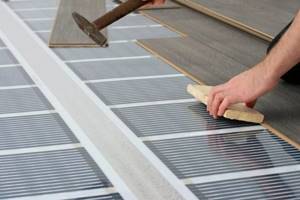
Cable is an electric floor that can function year-round. In order to reduce energy costs, special thermostats are built into the design. The structure itself is assembled from two- or three-core cables or electrical mats.
This method is optimal for tiles, as it helps them heat up quickly and retain heat.
The “floating floor” technology is very popular; Isover coating is used for it.
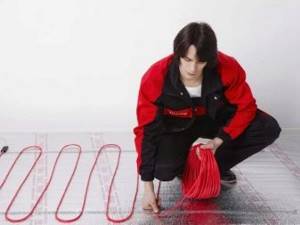
Laying technology
The technology for laying the substrate is simple and can be done independently. When installing a lining intended for heated floors, it is necessary to select its thickness depending on the type of system and the conditions under which it will be used.
The reflective side of the insulation should face the direction of the heat source. There should be an air gap of 15 - 20 mm between it and the finishing floor, for the circulation of air masses and the condensation process.
The main thing is to follow the established rules:
- Carrying out a calculation - determining the amount of material; it is better if the insulating layer has a minimum of seams.
- Preparing the base - it must be level, each difference will appear on the surface over time.
- Laying a waterproofing layer - it can be cork, chipboard, etc. Before this, you need to lay dense polyethylene, it will serve as a water barrier.
- Installation of the substrate (roll or sheet) - it is laid without tension, with the obligatory approach to the walls. The material must fit closely to vertical surfaces that are covered with damper tape.
- Connection - roll-type canvases (laid in an overlap) or mats (positioned in a joint) are combined using adhesive tape.
After this, you can begin installing the heating system. If a water- or electric-type heated floor is being laid, and a foam backing with bosses or a wooden backing with grooves is used, it is enough to place the pipe or cable in the grooves.
If the substrate is smooth, additional fixation will be required. Then you need to fill the screed, although there are ways to install heated floors without it. After which, you can begin the finishing coat.
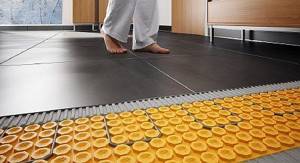
Laying an infrared mat floor is an easier option. The rolled material is simply rolled out onto a flat surface and secured with tape. A concrete screed is not required here; it is enough to put a plastic film on top and install the flooring.
To summarize, we can say that the substrate is a structural layer that cannot be avoided when installing any heated floor. You should not save on this material, as repairing the system will cost much more.
Properly installed hydro- and thermal insulation will provide heating of the room and reduce energy consumption costs.
Structure of a water heated floor
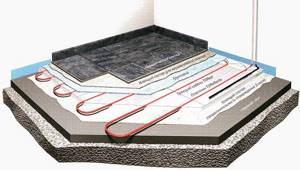
A warm floor consists of the following elements:
- Floor slab (reinforced concrete)
- Waterproofing, since the slightest moisture from below seriously impairs the thermal insulation properties of any insulating material
- Insulation (its task is to minimize heat losses downwards and create maximum heat flow upwards, i.e. into the room that we are trying to heat with our water heated floor system)
- Underfloor heating pipe from which heat flows in all directions
The minimum thickness of the screed is 65 millimeters and the minimum distance from the top edge of the pipe to the edge of the screed is 45 millimeters. A damper tape must be laid around the perimeter of the room to minimize heat loss through the walls and compensate for the expansion of the concrete screed. Since there is no rigid connection between the concrete screed and the wall, the screed breathes. Accordingly, it should be separated from the wall using a damper tape.
Our task is to direct the heat upward into the heated room and prevent it from going down into the basement or onto the street. This is why we are offered to install underlayment for heated floors.
Electric heated floor
It is also a multilayer structure, where the heat transfer element is a flexible electrical cable or heating rod mats operating from the electrical network. This type of heated floor is not prohibited from being installed in an apartment building.
Unlike a water floor, this floor is not subject to leakage, and if any element breaks, it is enough to dismantle only one section above it.
Electric heated floors, in turn, are divided into:
- cable (heating occurs using a flexible cable located between the floor slab and the floor covering);
- rod-type (heated using a carbon rod);
- infrared, also known as film (there are several types of heating, such as film with carbon stripes);
- heating mats (combination of cable with mesh backing).
Regardless of what type of floor has been chosen, an important component is the underlay for heated floors - a heat-insulating material.
Using material with foil
Installing foil under a heated floor is quite simple. With a 99% probability, even a novice builder will not encounter any difficulties or difficulties here. In order to lay this material on the subfloor, you will need scissors or a stationery knife, a tape measure, aluminum tape, and the heat-insulating material itself (for example, polyethylene foam).
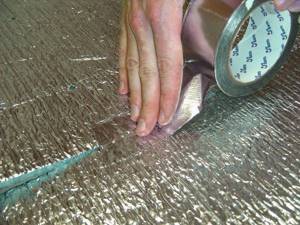
Let's start installation
The following table will help you navigate the entire installation technique.
Table. Technology for laying foil under heated floors.
| Steps, photo | Description of actions |
Step 1 | The material is laid close to the wall. The process starts from the corner of the room. The edge of the roll of foil material is placed in the corner of the room with the reflective side up - it will always be directed towards the heat source. The roll is unrolled to the end of the wall, a strip of material of the required length is cut. |
Step 2 | In a similar way, the material is rolled out across the floor of the entire room. The strips are laid end to end. |
Step 3 | All installation seams are taped to ensure maximum heat and moisture insulation. |
Step 4 | Next, the installation of a floor heating system can be carried out, then the flooring is laid. |
However, it is worth remembering that the foil underlay must be laid on a thoroughly dried subfloor if it has been leveled and filled with building mixture. Then the work on installing thermal insulation is carried out, and then the selected underfloor heating system is installed according to the diagram and certain requirements. After this, again, depending on the requirements, it is either filled with a cement mixture or simply covered with a finishing coating.

The underlay must be laid on a carefully prepared subfloor
